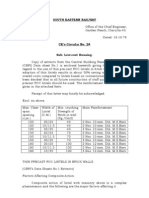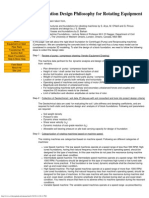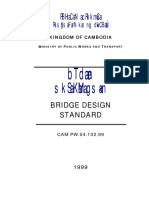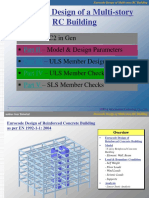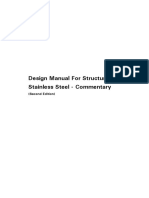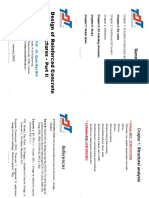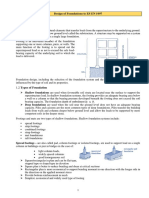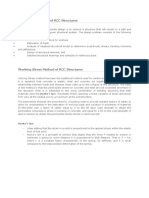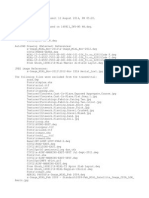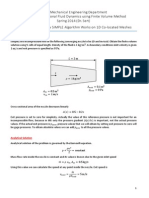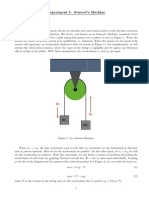Modulus of Subgrade Reaction - Which One To Use
Modulus of Subgrade Reaction - Which One To Use
Uploaded by
dubai_santanuCopyright:
Available Formats
Modulus of Subgrade Reaction - Which One To Use
Modulus of Subgrade Reaction - Which One To Use
Uploaded by
dubai_santanuOriginal Description:
Original Title
Copyright
Available Formats
Share this document
Did you find this document useful?
Is this content inappropriate?
Copyright:
Available Formats
Modulus of Subgrade Reaction - Which One To Use
Modulus of Subgrade Reaction - Which One To Use
Uploaded by
dubai_santanuCopyright:
Available Formats
Structural Services, Inc.
Modulus of Subgrade Reaction - Which One Should be Used?
By Wayne W. Walker, P.E. , F.ACI and Jerry A. Holland, P.E., F.ACI
The modulus of subgrade reaction is an often misunderstood and misused concept for the thickness design of
slabs-on-ground. Terzaghi in 1955 (Ref. 1, P. 300) attributed this confusion to the initial work by Hayashi in
1921 (Ref. 2), who stated that the subgrade reaction should be determined by a load test but failed to mention
that the tested results depend on the size of the loaded area. Additionally, Terzaghi noted that the well-known
book by Hetenyi Beams on Elastic Foundation (Ref. 3), published in 1946, did not contain any statement
regarding the adjustment factors necessary to the subgrade reaction value for the different loading conditions.
As stated by Terzaghi, This condition led to the erroneous conception, widespread among engineers, that the
numerical value of the coefficient of subgrade reaction depends exclusively on the nature of the subgrade. In
other words, it became customary to assume that this coefficient has a definite value for any given subgrade.
Terzaghi had hoped his paper in 1955 would finally clear up this confusion and provide the necessary factors
for making the appropriate adjustments to the subgrade reaction load test value. It has been over 60 years
since his paper has been published, and we still often see engineers using inappropriate values for the
subgrade reaction. Even with the many well-known text books that discuss the issue of subgrade reaction
adjustment factors (Ref. 4, P. 286 & 489; Ref. 5, P. 516-517; Ref. 6, P. 501-503; and Ref. 7, P. 416-417), this
issue is still frequently not being properly addressed. We hope, by providing detailed examples and specific
subgrade reaction values for different soil types for industrial slab loadings, that this approach will provide
clarity to this issue.
What is the modulus of subgrade reaction?
To add to the confusion, especially for the novice slab designer, this value has been called by many different
names in various publications such as modulus of subgrade reaction, subgrade reaction, subgrade modulus,
coefficient of subgrade reaction, Winkler foundation (E. Winkler first proposed the subgrade reaction in 1867
[Ref. 16]) , Winkler subgrade, K value, etc.. In our paper, we will use either subgrade reaction or the
shortened K for our discussions.
The basic equation is:
which has units of pounds/in2/in or commonly used units of pounds/in3 or pci. There is an ASTM D1196 (Ref.
8) for the plate load test, which typically uses a 30 in. diameter plate as shown in Fig. 1.
Structural Services, Inc. Page 1 of 11
In our paper, we will refer to Kp as the subgrade reaction based on the 30 in. diameter plate load test.
The subgrade reaction is not a fundamental soil property. It is a lump constant of which the subgrade reaction
from the plate load test should be adjusted because the subgrade reaction is a function of:
1. Soil elastic properties, both the initial response and the long-term response due to soil consolidation
from the sustained loading.
2. Loading intensity that will influence the long-term consolidation settlement.
3. Amount of surface area loaded and load shape over which the load is applied. Wider and larger area
loadings will involve consolidation of the deeper soil layers.
4. Stiffness of the slab, which will influence the distribution of the soil bearing pressure.
Additionally, using the subgrade reaction (Winkler foundation) has other analytical limitations. The
displacement at one location does not influence the settlements at other locations, which is not correct as
shown in Fig. 2.
Structural Services, Inc. Page 2 of 11
Using the subgrade reaction soil springs (Winkler foundation) has been referred to as an uncoupled
foundation because the springs do not interact with each other. Whereas using the solid finite element
foundation, the soil settlements are coupled. In other words, the soil settlements at the loaded areas also
cause other unloaded areas to settle as well. To improve the accuracy of the subgrade reaction adjustment
factors, we have equated the slab stresses for a slab on a solid finite element foundation (coupled model) with
a slab using an equivalent subgrade reaction (uncoupled model), as shown in Fig. 5 and values in Table 1.
This equalization will adjust the subgrade reaction value for wide area loading effects, consolidation of the
deeper layers of the soil, and help minimize the uncoupled analytical limitation of the subgrade reaction
foundation system.
Who makes the adjustments to the subgrade reaction values?
Along with the widespread misconception that the subgrade reaction is a single value, this issue is further
complicated because it is not clear in the industry who makes the adjustments to the subgrade reaction for the
different load cases. The structural engineer often sees a single value in the geotechnical report that typically
does not have any qualifiers regarding how the stated subgrade reactions is to be used and assumes (or more
likely is uninformed on the limitations on using the subgrade reaction foundation) the geotechnical engineer
has made the adjustments to the provided subgrade reaction. The geotechnical engineer typically provides in
the geotechnical report the value to use for wheel loadings but often does not provide any qualifiers or limits on
how the subgrade reaction is to be used. The geotechnical engineer assumes (or more likely did not consider
the limits of the provided subgrade reaction) the structural engineer will make the adjustments based on the
different loading cases. As you can see from the scenario above, there is much confusion regarding who is
responsible for making the adjustments to the subgrade reaction for the different load cases.
In our opinion, the responsibility is shared jointly between the structural engineer and the geotechnical
engineer for determining the proper subgrade reaction to be used for the different load cases. The structural
engineer has the responsibility to:
1. Provide the load intensity on the slab and the type of load (such as lift-truck or other vehicle loadings,
long-term uniform storage or rack loads, line or wall loads, etc.)
2. Provide the amount and size of slab surface areas that will be loaded and the length of time the load
will be applied. It is important that the geotechnical engineer know if the slab will have a wide area
loading. Wide area loadings will cause deeper soil consolidation settlements (assuming long-term
settlements are significant for the project soil types) if the loads are sustained for a long period of time.
3. Provide the owners and/or equipments sensitivity to slab cracking, soil settlements (initial and long-
term consolidation), slab sloping due to soil settlements, etc.
The geotechnical engineer has the responsibility to:
1. Use the information provided by the structural engineer and the site soil properties to provide
recommendations for subgrade reactions to be used for the different load cases.
2. Recommend any testing that needs to be performed to support the provided subgrade reactions values.
Typically for industrial slabs, the geotechnical engineer should provide two subgrade reactions. The first
subgrade reaction is for short-term loadings to be used for loads such as lift-truck wheel loads. These loads
only affect the first few feet of the soil and have little, if any, long-term consolidation settlements. The second
subgrade reaction is for long-term loadings to be used for loads such as wide area rack or uniform storage
loads. These loads affect many feet of soil below the slab and have both initial and possible long-term soil
consolidation settlements (depending on the soil type). These subgrade reaction values should be stated on
the structural project drawing general notes design criteria. ACI 360R (Ref. 9, P. 67) has provided an example
design criteria showing how these subgrade reaction values should be shown on the drawings.
Structural Services, Inc. Page 3 of 11
Subgrade reaction values for short-term loads over small areas, such as wheel loads
For short duration loadings over small areas, such as wheel loads from lift trucks, where only a few feet of soil
is affected below the slab and where long-term soil consolidation is not a concern, the subgrade reaction value
from the plate load test should be used. Because these types of loads only affect the first few feet of soil, the
subgrade reaction can be improved or increased with a granular aggregate or cement-treated (or other
stabilizing materials) base material (Refs. 10 and 11). Tables and charts for these increased subgrade
reaction values using base materials can be found in a number of publications (Ref. 12, P. 6; Ref. 13, P. 6;
Ref. 14, P. 3).
Subgrade reaction values for wide area long-term sustained loads, such as uniform loading or rack
loads
Determining the appropriate subgrade reaction values for wide area sustained loadings is more complicated
than for short-term loadings. These loads involve deeper layers of soil that may or may not have significant
long-term consolidation settlements, depending on the soil type. Additionally, as discussed by Terzaghi
(Ref. 1, P. 306), the soil settlements used to adjust the plate load subgrade reaction are the settlements above
the nearly uniform pressure elevation, as shown in Fig. 3.
For soil settlements occurring below the nearly uniform pressure line, the entire slab moves down causing little
influence on the differential deflections of the slab, and therefore the slab moments are not significantly
affected. Some papers and text books have provided linear relationships of subgrade reaction with the bearing
pressure used for foundation design, but these relationships would not be entirely correct because these
relationships include the soil settlements below the nearly uniform pressure line. Additionally, using a thin
layer of granular aggregate or cement treated base material to improve or increase the subgrade reaction for
wheel loadings will only have a minimal effect for wide area sustained loadings because the deeper layers of
soil are affected more.
Structural Services, Inc. Page 4 of 11
To provide reasonable approximations of subgrade reactions for wide area sustained loadings, we have used
two computer models as shown in Fig. 5. Fortunately, the slab stress analysis is not sensitive to the value of
the subgrade reaction (large changes to the subgrade reaction only causes small changes to the slabs
stresses); therefore, a reasonably approximate subgrade reaction is all that is needed for slab designs. The
first computer model uses solid finite elements, which by the nature of the analysis will only produce stresses
in the slab for settlements above the nearly uniform pressure elevation. The second computer model will use
an equivalent subgrade reaction that will produce the same maximum stresses in the slab. By equating these
two computer models, the equivalent subgrade reaction will have the reduction due to the wide area sustained
loading.
The following is an example to illustrate our approach for determining the subgrade reaction for wide area
sustained loadings. Fig. 4 shows the typical rack configuration of 4 ft. by 8 ft. with a 1 ft. flue space and an 8 ft.
wide aisle used for our analysis. Aisle spacing can vary depending on the type of storage racking systems
used. A storage racking system using a conventional lift truck commonly has aisle widths of 10 to 11 ft. A
storage racking system that uses a narrow aisle racking system typically has aisle widths of 5 to 6 ft. As
discussed above, only a reasonably approximate subgrade reaction is needed for slab design; therefore, we
used an 8 ft. aisle width to approximate the two different storage racking system aisle widths.
Structural Services, Inc. Page 5 of 11
Fig. 5 shows the two computer models side-by-side. We used a 6 thick concrete slab supporting a rack post
load of 7,000 pounds per post, which is a common long-term sustained loading for a distribution warehouse
facility. Table 1 shows the soils elastic moduli Es and Poissons ratios used for the different soil types.
These soil values have a wide variation and are a composite from Ref.s 5, 6 and 17. Fortunately, the way the
analysis is performed by equating the two different models, only reasonable approximations of these soil
values are needed.
For our example, we used a medium stiff clay with the soil modulus and Poissons ratio values shown in
Table 1. To approximate the long-term soil consolidation for the clay soils, we used of the soil modulus. For
our example, that would provide a value of 2,400 psi ( of 4,800 psi). Using of the soil modulus would
approximately estimate the soil consolidation settlement to be nearly equal to the initial elastic settlement. For
sandy soils, typically there are only initial elastic settlements and little long-term consolidation settlements.
Therefore, long-term soil consolidation settlements were not considered for the sandy soils (the full elastic soil
modulus was used in the analysis for sandy soils). These soil assumptions should be reviewed by the project
geotechnical engineer and modified if needed for the site specific soil conditions.
By running several computer iterations, the equivalent subgrade reaction that produces the same maximum
slab stress as the solid element model can be determined. For our example, the equivalent modulus of
subgrade reaction was determined to be 80 pci. The 80 pci would have both the reduction of wide area
loading and the reduction for long-term soil consolidation. The 80 psi would be 35% (80 pci/230 pci X 100%)
of the plate subgrade reaction value. This reduction is in the range of other published reductions (Ref. 9,
P. 13). The slab stresses are shown in Fig. 6.
Structural Services, Inc. Page 6 of 11
As discussed above, the nearly uniform soil pressure location for this model is approximately 14 ft. below the
slab as shown in Fig. 7. In other words, the settlements in the 14 ft. of soil below the slab are the only ones
that significantly affect the slabs stresses.
Structural Services, Inc. Page 7 of 11
Fig. 8 shows the computer models side-by-side slab deflections. The computer model using the solid finite
elements will provide the total settlements for the loading, which has a maximum deflection of 0.152 in. The
computer model using the subgrade reaction only provides the differential deflection from the slabs top surface
and has a maximum deflection of 0.033 in. Notice that the differential deflection of 0.031 in. and 0.024 in are
nearly the same for both models, which correspondingly provides the same slab maximum stresses for both
computer models. The differential deflections will not be exactly the same because the springs in the subgrade
reaction model are uncoupled.
Structural Services, Inc. Page 8 of 11
To determine the plate subgrade reaction Kp as shown in Fig. 1 above, the equation (Ref. 15, P. 408) for a
concentrated load applied to a circular plate on a semi-infinite solid can be used.
1
.1
2
Where:
P = Load applied to the plate
= Deflection of the circular plate
R = Radius of the plate
Es = Soils elastic modulus
= Poissons ratio
Substituting the following two equations EQ. 2 and EQ. 3 into EQ. 1:
. 2
. 3
Where:
Kp = Plate subgrade reaction
= Average soil pressure below the plate
= Deflection of the circular plate
And writing the equation in terms of Kp provides:
2
. 4
1
Structural Services, Inc. Page 9 of 11
It can be clearly seen from EQ. 4 that the subgrade reaction is not a defined value but depends on both the soil
type and area loaded. This equation was used to determine plate subgrade modulus values in Table 1.
These values are shown for information only
and should not be used for slab designs with
these types of soils. The Kws values should
Table 1 Subgrade Reaction Design Values be used for these types of soils.
Ratio Ratio
Es Kp Kw Kw Kws Kws
Soil Type (psi) (PCI) (PCI) Kp (PCI Kp
Clay Soft 2,000 0.45 110 70 0.64 50 0.45
Medium 4,800 0.35 230 130 0.57 80 0.35
Hard 10,600 0.20 470 260 0.55 140 0.30
Sandy 15,600 0.25 710 390 0.55 200 0.28
Sand Silty 2,000 0.30 90 70 0.78 --- ---
Loose 2,500 0.30 120 80 0.67 --- ---
Dense 9,500 0.35 460 240 0.52 --- ---
Plate subgrade reaction Subgrade reaction design Subgrade reaction design
design values used for short- values reduced for wide area values reduced for wide
term loadings over small storage loadings, such as area storage loadings,
areas, such as vehicle wheel uniform or rack loads. such as uniform or rack
loads. Typically, sandy soils have loads, and reduced due to
mostly initial elastic long-term soil
settlements and little long- consolidation settlements
term soil consolidation. typical of clay types of
Therefore, these values are soils.
not reduced for long-term soil
consolidation.
Table 1 - Notes:
1. Kp is the plate subgrade reaction value.
2. Kw is the subgrade reaction reduced for wide area loading.
3. Kws is the subgrade reaction reduced for wide area loading and long-term soil settlement
consolidation.
Conclusion
It is our hope that this paper will provide the much needed clarity regarding what value of subgrade reaction
should be used for the different loading cases, how the value should be determined, and the joint
responsibilities of the structural and geotechnical engineers for determining the proper subgrade value to be
used.
As discussed above, the proper subgrade reaction is a function of several variables, and the values in Table 1
are only valid for the stated assumptions. These values may not be appropriate for mats, large/heavy
equipment foundations, tank foundations, continuous beams, etc.
Structural Services, Inc. Page 10 of 11
References:
1. Terzaghi, K., 1955, "Evaluation of Coefficient of Subgrade Reaction," Geotechnique, vol. 5, no. 4 Dec.,
pp. 297-326.
2. Hayashi, K., 1921, Theory of Beams on Elastic Foundation, Springer-Verlag (in German).
3. Hetenyi, M., 1946, Beams on Elastic Foundation: Theory with Applications in the Fields of Civil and
Mechanical Engineering , Univ. of Michigan Press, Ann Arbor, Michigan.
4. Peck, Ralph B., and Terzaghi, Karl, 1967, Soil Mechanics in Engineering Practice, John Wiley & Sons, Inc.
New York.
5. Winterkorn, Hans F., and Fang, Hsai- Yang, 1975, Foundation Engineering Handbook, Van Nostrand
Reinhold Company.
6. Bowles, Joseph E., 1996, Foundation Analysis and Design, 5th ed., McGraw- Hill Co.
7. Sowers, George B., and Sowers, George F., 1970, Introductory Soil Mechanics and Foundations, 3rd ed.,
Macmillan Publishing Co.
8. ASTM D 1196 12 Standard Test Method for Nonrepetitive Static Plate Load Tests of Soils and Flexible
Pavement Components, for Use in Evaluation and Design of Airport and Highway Pavements
9. American Concrete Institute (ACI) 360R-10 "Guide to Design of Slabs-on-Ground", Farmington Hills, MI.
10. Childs, L. D., 1967, Cement-Treated Subbases for Concrete Pavements, Highway Research Record 189,
Highway Research Board, pages 19 to 43; also PCA Development Department Bulletin DX125.
11. Burmister, D. M., 1943, The Theory of Stresses and Displacements in Layered Systems and Applications
to Design of Airport Runways, " Highway Research Board Proceedings, Vol. 23, pages 126 to 148.
12. American Concrete Institute (ACI) 330R-08 "Guide for the Design and Construction of Concrete Parking
Lots, Farmington Hills, MI.
13. Portland Cement Association, 1984, Thickness Design for Concrete Highway and Street Pavements,
Engineering Bulletin No. EB109.01P, Portland Cement Association, Skokie, IL.
14. Packard, R. G., 1976, Slab Thickness Design for Industrial Concrete Floors on Grade, ISI95.01D,
Portland Cement Association, Skokie, IL.
15. Timoshenko, S. P., Goodier, J. N., 1970, Theory of Elasticity, 3rd ed., McGraw- Hill Co.
16. Winkler, E. ,1867, "Die Lehre von der Elastizitat and Festigkeit (on elasticity and fixity)", Prague, Verlag,
p. 182.
17. EM 1110-1-1904, 1990, U.S. Army Corps of Engineers Engineer Manual, Settlement Analysis, 30SEP90.
Wayne W. Walker, P.E., F.ACI, is a Principal and the Director of
Engineering Services at Structural Services, Inc. He is on several
ACI committees and has been a speaker at ACI seminars. He has
also published other papers and has developed many computer
programs to analyze and design slabs and other structures.
Jerry A. Holland, P.E., F.ACI, is a Principal, Vice-President and the
Director of Design Services for Structural Services, Inc. He is on
several ACI committees, teaches seminars for ACI and the World of
Concrete. He has also published other papers and has more than 45
years of experience worldwide with the design, construction, and
troubleshooting of concrete slabs other structures.
Download paper from SSIs Web site: http://www.ssiteam.com/publications
Structural Services, Inc. Page 11 of 11 08APR16
You might also like
- Detailed Lesson Plan in Science 9 Quarter 3Document8 pagesDetailed Lesson Plan in Science 9 Quarter 3shirley cortez91% (11)
- Clark1976 PDFDocument10 pagesClark1976 PDFLuis Ariel B. MorilloNo ratings yet
- Power DistributionDocument57 pagesPower Distributiondubai_santanu100% (1)
- IS 3370 Part 2 - 2009Document14 pagesIS 3370 Part 2 - 2009Nagamani Venkataramana100% (1)
- Chapter 3 Bearing Capacity PDFDocument11 pagesChapter 3 Bearing Capacity PDFIan SeguritanNo ratings yet
- (Type The Document Title) : Title - California Bearing RatioDocument7 pages(Type The Document Title) : Title - California Bearing RatioDebasish Dev BarmaNo ratings yet
- Brick LintelsDocument17 pagesBrick LintelsBharanidharan SelvanNo ratings yet
- Civil Design HelpDocument4 pagesCivil Design HelpRanjan ParajuliNo ratings yet
- បទដ្ឋានសិក្សាគំរោងស្ពាន CAM PW 04 102 99Document66 pagesបទដ្ឋានសិក្សាគំរោងស្ពាន CAM PW 04 102 99Pu VidNo ratings yet
- App5 EC2 DesignDocument70 pagesApp5 EC2 Designm_ganea268973No ratings yet
- Standard Notes CBE29-3 Construction in Civil Engineering 20150222Document37 pagesStandard Notes CBE29-3 Construction in Civil Engineering 20150222Genie LoNo ratings yet
- Design of Anchor Bolts-Recent Developments-ICJ 103 PDFDocument8 pagesDesign of Anchor Bolts-Recent Developments-ICJ 103 PDFSheiss NabiNo ratings yet
- Design Manual For Structural Stainless Steel - CommentaryDocument105 pagesDesign Manual For Structural Stainless Steel - CommentaryRajeev DuaNo ratings yet
- Tài Liệu 1 PDFDocument122 pagesTài Liệu 1 PDFThanh HuyNo ratings yet
- Design Calculation FoundationDocument3 pagesDesign Calculation Foundationmsiddiq1No ratings yet
- Tension & Shear CapacityDocument5 pagesTension & Shear CapacityFaridUddinNo ratings yet
- T1 - Structural Assessment and Design - Dec 2020Document17 pagesT1 - Structural Assessment and Design - Dec 2020Abdulrahman Alnashar0% (1)
- 1 - R-633 Structural Concept Report - Stage 2 - 2012-09-13Document19 pages1 - R-633 Structural Concept Report - Stage 2 - 2012-09-13Parth Daxini100% (1)
- DFI-Diaphragm Walls As Permanent Basement Walls in Region of High SeismicityDocument20 pagesDFI-Diaphragm Walls As Permanent Basement Walls in Region of High SeismicityUriel HerreraNo ratings yet
- Load TypesDocument5 pagesLoad TypesKutty MansoorNo ratings yet
- Retaining Wall TerminologyDocument2 pagesRetaining Wall Terminologyhammads88No ratings yet
- Stiffness Modification Factor in Sap2000Document1 pageStiffness Modification Factor in Sap2000husrem2001No ratings yet
- Reinforced Concrete Slab Design Using The Empirical MethodDocument9 pagesReinforced Concrete Slab Design Using The Empirical MethodRezky MuliaNo ratings yet
- IS875 (Part3) - Wind Loads On Buildings and Structures - IIT Kanpur-Part 3Document7 pagesIS875 (Part3) - Wind Loads On Buildings and Structures - IIT Kanpur-Part 3Adam Michael GreenNo ratings yet
- Microsoft Word - Design Station Purlins & Girts-Rev3Document31 pagesMicrosoft Word - Design Station Purlins & Girts-Rev3khairul4008No ratings yet
- NZS 4402 Methods of Testing Soils For Civil Engineering Purposes. 1988Document6 pagesNZS 4402 Methods of Testing Soils For Civil Engineering Purposes. 1988Christian Aliste Fernandez100% (1)
- Chapter Two Soil Settlement: September 2019Document28 pagesChapter Two Soil Settlement: September 2019NOor AlhoDaNo ratings yet
- 2007d 3 ServiceLifeDesign Chloride AttackDocument36 pages2007d 3 ServiceLifeDesign Chloride AttackHyunkyoun Jin100% (1)
- Strength Behavior of Cement Treated Dredged SoilDocument20 pagesStrength Behavior of Cement Treated Dredged SoilTarhata KalimNo ratings yet
- Effect of Backstay On 3B+G+20 Storey RC BuildingDocument5 pagesEffect of Backstay On 3B+G+20 Storey RC Buildingdharashah28No ratings yet
- Holding Down BoltsDocument5 pagesHolding Down BoltsLukeNo ratings yet
- "Anchor Reinf." - Anchor Reinforcement Analysis: Program DescriptionDocument6 pages"Anchor Reinf." - Anchor Reinforcement Analysis: Program DescriptionTimo SchenkoNo ratings yet
- Cantilever Retaining Walls 2019Document8 pagesCantilever Retaining Walls 2019yassir dafallaNo ratings yet
- Rebound Hammer DirectionsDocument3 pagesRebound Hammer DirectionsEric Cruz Atienza100% (1)
- Preliminary Structural Design PDFDocument8 pagesPreliminary Structural Design PDFKenny Manuel VettoorNo ratings yet
- Cantilever Sheet Pile Wall, SI Units (DeepEX 2015) PDFDocument13 pagesCantilever Sheet Pile Wall, SI Units (DeepEX 2015) PDFchriscivil12No ratings yet
- Pile Analysis (As2159) in Accordance With Australian Standard: Piling-Design and Installation Per AS 2159-2009Document3 pagesPile Analysis (As2159) in Accordance With Australian Standard: Piling-Design and Installation Per AS 2159-2009PhranckNo ratings yet
- Tài Liệu PDFDocument243 pagesTài Liệu PDFThanh HuyNo ratings yet
- Sheet 19 NCSPA Design Data SheetDocument12 pagesSheet 19 NCSPA Design Data SheetVietanh PhungNo ratings yet
- Tie Back WallDocument13 pagesTie Back WallMinhLêNo ratings yet
- Guidelines For Site Inspection - by Blas R. Cadalso1Document18 pagesGuidelines For Site Inspection - by Blas R. Cadalso1abstickleNo ratings yet
- Difference Between Working Stress Method and Limit State MethodDocument5 pagesDifference Between Working Stress Method and Limit State MethodDeep DebnathNo ratings yet
- Design of FoundationDocument26 pagesDesign of Foundationmessinho70% (1)
- Section 4.0 Standard Specification For Structural Steel (Rev0 20151221)Document71 pagesSection 4.0 Standard Specification For Structural Steel (Rev0 20151221)YUK LAM WONGNo ratings yet
- Raft Analysis and Design - Some Practical ExamplesDocument12 pagesRaft Analysis and Design - Some Practical ExamplesCw Tan100% (1)
- Guidlinew For Deep Foundation Shafts Wells Retaining StructuresDocument200 pagesGuidlinew For Deep Foundation Shafts Wells Retaining StructurespsaroudakisNo ratings yet
- Design ReportDocument9 pagesDesign ReportMarcmorollaNo ratings yet
- Recommended Practice For Precast Prestressed Concrete Circular Storage TanksDocument46 pagesRecommended Practice For Precast Prestressed Concrete Circular Storage TanksFabricio ChavarriaNo ratings yet
- ACI 318-99 - Sap2000 Concrete Design (Eng) PDFDocument25 pagesACI 318-99 - Sap2000 Concrete Design (Eng) PDFismailarchNo ratings yet
- Slab Bridge DesignDocument1 pageSlab Bridge DesignMars VillalunaNo ratings yet
- 9479 0801 12.10.2015 Madan Mohan Malviya Tech. University GorakhpurDocument17 pages9479 0801 12.10.2015 Madan Mohan Malviya Tech. University GorakhpurAnoopNo ratings yet
- Foundation Design To ES EN 1997Document24 pagesFoundation Design To ES EN 1997Abebe Wolde100% (1)
- Comprehensive Step by Step Calculations For Retaining Wall Analysis Are Provided BelowDocument15 pagesComprehensive Step by Step Calculations For Retaining Wall Analysis Are Provided BelowLakshmiWijayasiriNo ratings yet
- Csi Analysis Reference Manual For Sap2000 Etabs and Safe PDFDocument433 pagesCsi Analysis Reference Manual For Sap2000 Etabs and Safe PDFresurrection786No ratings yet
- Keynote D.V. KarandikarDocument47 pagesKeynote D.V. KarandikarlingamkumarNo ratings yet
- WSM Vs ULM Vs LSMDocument3 pagesWSM Vs ULM Vs LSMSameer BelimNo ratings yet
- ModulusofSubgradeReaction PDFDocument11 pagesModulusofSubgradeReaction PDFHAMIDNo ratings yet
- Effect of Soil Nonlinearity On AnalysisDocument9 pagesEffect of Soil Nonlinearity On AnalysisArjun PaudelNo ratings yet
- 78-84 H.G. Poulos - Piled Raft Foundations For Tall BuildingsDocument7 pages78-84 H.G. Poulos - Piled Raft Foundations For Tall Buildingsajaymr100% (1)
- The Design of High-Rise Building FoundationsDocument12 pagesThe Design of High-Rise Building Foundationswilliam_cheangNo ratings yet
- Design of Piled Raft Foundations For Tall BuildingsDocument7 pagesDesign of Piled Raft Foundations For Tall BuildingsnhulugallaNo ratings yet
- Effect of Pile Diameter On Subgrade Modulus - 3 PagesDocument3 pagesEffect of Pile Diameter On Subgrade Modulus - 3 PagesScooby DooNo ratings yet
- Candidate Basic Information SheetDocument6 pagesCandidate Basic Information Sheetdubai_santanuNo ratings yet
- Twy-M5 M4Document3 pagesTwy-M5 M4dubai_santanuNo ratings yet
- Appendix D - Packer Test Data Analysis 101029Document82 pagesAppendix D - Packer Test Data Analysis 101029dubai_santanu100% (1)
- Standard Specs For ConstructionDocument542 pagesStandard Specs For Constructiondubai_santanuNo ratings yet
- Proposal Form Andaman SantanuDocument4 pagesProposal Form Andaman Santanudubai_santanuNo ratings yet
- 11 Final PhysicsDocument3 pages11 Final PhysicsMubashshir Al NahyanNo ratings yet
- NPT Threaded and Socket Welding Fittings ANSI Standard 3000lbsDocument10 pagesNPT Threaded and Socket Welding Fittings ANSI Standard 3000lbsHongwei GuanNo ratings yet
- Seismic Strengthening and Repair of RC Shear Walls PDFDocument8 pagesSeismic Strengthening and Repair of RC Shear Walls PDFSri LathaNo ratings yet
- Mechanical Mini Project ThesisDocument5 pagesMechanical Mini Project Thesiserinrossportland100% (1)
- Stafsjo MV Knife Gate Data SheetDocument9 pagesStafsjo MV Knife Gate Data Sheetwijaya adidarmaNo ratings yet
- CR Data BookDocument111 pagesCR Data BookLuisNo ratings yet
- 3029hfu20 A15Document3 pages3029hfu20 A15OGNo ratings yet
- 3NAB0 - Problems Chapter 4Document2 pages3NAB0 - Problems Chapter 4seherNo ratings yet
- Maintenace Intervale Schedule 980HDocument5 pagesMaintenace Intervale Schedule 980HAlberto BastidasNo ratings yet
- Troubleshooting - Discharge PressureDocument5 pagesTroubleshooting - Discharge PressureSanjoy deyNo ratings yet
- Artificial Lift For Guest LectureDocument117 pagesArtificial Lift For Guest LectureZenga Harsya Prakarsa100% (3)
- Binzel Cable Cat 2Document4 pagesBinzel Cable Cat 2alessia olgiatiNo ratings yet
- Types of Refrigeration SystemsDocument16 pagesTypes of Refrigeration SystemsmeriiNo ratings yet
- Chapter - 1Document39 pagesChapter - 1ritesh chauhanNo ratings yet
- From Toe THC-1 Drilling Machine. Document Number C76Document9 pagesFrom Toe THC-1 Drilling Machine. Document Number C76Rupesh DangolNo ratings yet
- Apcy H 2018 PDFDocument72 pagesApcy H 2018 PDFEmad Elnoo PyNo ratings yet
- Learn How To Remove and Install Various Tub SpoutsDocument19 pagesLearn How To Remove and Install Various Tub SpoutsAngieNo ratings yet
- New Microsoft Word DocumentDocument7 pagesNew Microsoft Word DocumentAmr AliNo ratings yet
- Radial Drills: TPR720A TPR820A TPR920A TPR1100Document86 pagesRadial Drills: TPR720A TPR820A TPR920A TPR1100Mohamed ShabanNo ratings yet
- Gi Sheet Weight ChartDocument15 pagesGi Sheet Weight Chartmab0% (1)
- Work Energy and PowerDocument39 pagesWork Energy and PowerRoselyn CarmenNo ratings yet
- 1988SaliversonPhD PDFDocument212 pages1988SaliversonPhD PDFMohamed Ali ChebbiNo ratings yet
- Ecas WabcoDocument34 pagesEcas WabcoBom_Jovi_68183% (6)
- Trabjo en Grupo Fisica MecanicaDocument14 pagesTrabjo en Grupo Fisica MecanicadilanNo ratings yet
- High Impact Polystyrene For Injection Molding: Typical ApplicationsDocument1 pageHigh Impact Polystyrene For Injection Molding: Typical Applicationshasan30784No ratings yet
- 1D Colocated SIMPLE SolutionDocument14 pages1D Colocated SIMPLE Solutionosmanpekmutlu100% (1)
- AtwoodDocument3 pagesAtwoodBahril IlmiwanNo ratings yet
- MTBF MTTR CalDocument1 pageMTBF MTTR CalarunradNo ratings yet
- R1 - 100701492-Pro-004 - Uf P&idDocument1 pageR1 - 100701492-Pro-004 - Uf P&idPrashant HuddarNo ratings yet






